(PDF) Supply Chain Management - Assignment
Added on 2021-11-24
58 Pages19917 Words179 Views
1
Table of Contents
1. Integration & The Role of Supply Management.................. 3
1.1. Definition ............................................... 4
1.2. Internal Integration - Supply Management’s Internal Linkages
................................................................. 6
1.2.1. Operations ........................................... 7
1.2.2. Quality Assurance .................................... 8
1.2.3. Engineering .......................................... 8
1.2.4. Accounting and Finance ............................... 9
1.2.5. Marketing/Sales ...................................... 9
1.2.6. Legal ................................................ 9
1.2.8. Environmental Management, Health, and Safety ........ 10
1.3. External Integration - Supply Management’s External Linkages
................................................................ 10
1.3.1. Suppliers ........................................... 10
1.3.2. Government .......................................... 10
1.3.3. Local Communities ................................... 11
1.4. Supplier Relationship Management ........................ 11
1.4.1. Collaborative Buyer-Seller Relationships ............ 11
1.4.2. Advantages of Closer Buyer-Seller Relationships ..... 12
1.4.3. Obstacles to Closer Buyer-Seller Relationships ...... 13
1.4.4. Extra Reading – Critical Elements for Supplier
Relationship Management ....................................... 13
2. Aligning Supply Management and Enterprise Objectives........ 16
2.1. Integrative Strategy Development ........................ 19
2.2. Translating Supply Management Objectives into Supply
Management Goals ................................................ 20
2.2.1. Cost-Reduction Objective ............................ 20
2.2.2. Technology/New-Product Development Objective ........ 21
2.2.3. Supply Base Reduction Objective ..................... 21
2.2.4. Supply Assurance Objective .......................... 21
2.2.5. Quality Objective ................................... 21
3. Supply management strategy.................................. 21
Table of Contents
1. Integration & The Role of Supply Management.................. 3
1.1. Definition ............................................... 4
1.2. Internal Integration - Supply Management’s Internal Linkages
................................................................. 6
1.2.1. Operations ........................................... 7
1.2.2. Quality Assurance .................................... 8
1.2.3. Engineering .......................................... 8
1.2.4. Accounting and Finance ............................... 9
1.2.5. Marketing/Sales ...................................... 9
1.2.6. Legal ................................................ 9
1.2.8. Environmental Management, Health, and Safety ........ 10
1.3. External Integration - Supply Management’s External Linkages
................................................................ 10
1.3.1. Suppliers ........................................... 10
1.3.2. Government .......................................... 10
1.3.3. Local Communities ................................... 11
1.4. Supplier Relationship Management ........................ 11
1.4.1. Collaborative Buyer-Seller Relationships ............ 11
1.4.2. Advantages of Closer Buyer-Seller Relationships ..... 12
1.4.3. Obstacles to Closer Buyer-Seller Relationships ...... 13
1.4.4. Extra Reading – Critical Elements for Supplier
Relationship Management ....................................... 13
2. Aligning Supply Management and Enterprise Objectives........ 16
2.1. Integrative Strategy Development ........................ 19
2.2. Translating Supply Management Objectives into Supply
Management Goals ................................................ 20
2.2.1. Cost-Reduction Objective ............................ 20
2.2.2. Technology/New-Product Development Objective ........ 21
2.2.3. Supply Base Reduction Objective ..................... 21
2.2.4. Supply Assurance Objective .......................... 21
2.2.5. Quality Objective ................................... 21
3. Supply management strategy.................................. 21
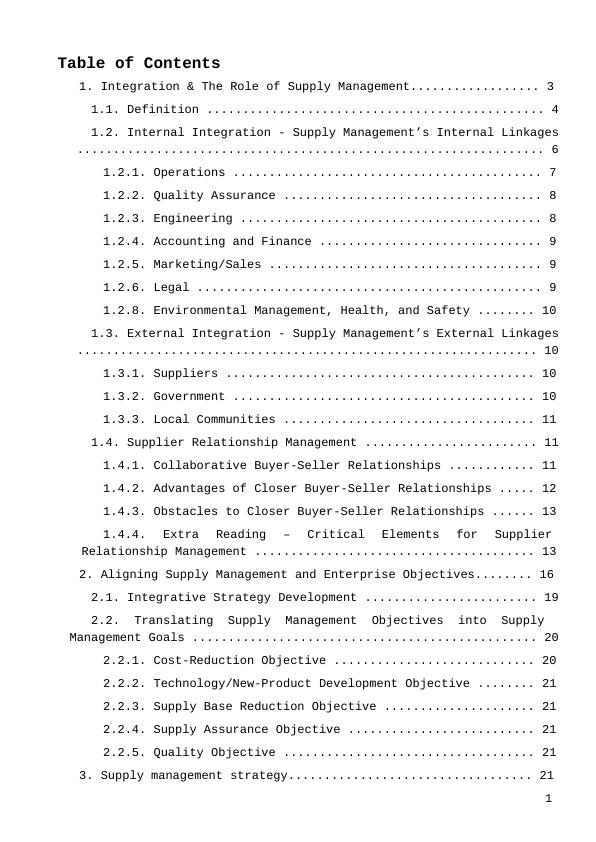
2
3.1. Category strategy ....................................... 21
3.1.1. What Is Category Strategy ........................... 21
3.1.2. Extra Reading - Conducting a Spend Analysis ......... 23
3.1.3. Extra Reading - Spend Analysis Spreadsheet .......... 25
3.2. Category Strategy Development ........................... 31
3.2.1. Step 1: Build the Team and the Project Charter ...... 32
3.2.2. Step 2: Conduct Market Research on Suppliers ........ 33
3.2.3. Step 3: Strategy Development ........................ 40
3.2.4. Step 4: Contract Negotiation ........................ 46
3.2.5. Step 5: Supplier Relationship Management ............ 48
3.3. Types of Supply Management Strategies ................... 50
3.3.1. Supply Base Optimization ............................ 50
3.3.2. Supply Risk Management .............................. 50
3.3.3. Global Sourcing ..................................... 52
3.3.4. Longer-Term Supplier Relationships .................. 53
3.3.5. Early Supplier Design Involvement ................... 53
3.3.6. Supplier Development ................................ 54
3.3.7. Total Cost of Ownership ............................. 54
3.4. Supply Management Strategy Evolution .................... 54
3.4.1. Phase 1: Basic Beginnings ........................... 55
3.4.2. Phase 2: Moderate Development ....................... 56
3.4.3. Phase 3: Limited Integration ........................ 56
3.4.4. Phase 4: Fully Integrated Supply Chains ............. 57
3.4.5. Observations on Supply Management Strategy Evolution 58
3.1. Category strategy ....................................... 21
3.1.1. What Is Category Strategy ........................... 21
3.1.2. Extra Reading - Conducting a Spend Analysis ......... 23
3.1.3. Extra Reading - Spend Analysis Spreadsheet .......... 25
3.2. Category Strategy Development ........................... 31
3.2.1. Step 1: Build the Team and the Project Charter ...... 32
3.2.2. Step 2: Conduct Market Research on Suppliers ........ 33
3.2.3. Step 3: Strategy Development ........................ 40
3.2.4. Step 4: Contract Negotiation ........................ 46
3.2.5. Step 5: Supplier Relationship Management ............ 48
3.3. Types of Supply Management Strategies ................... 50
3.3.1. Supply Base Optimization ............................ 50
3.3.2. Supply Risk Management .............................. 50
3.3.3. Global Sourcing ..................................... 52
3.3.4. Longer-Term Supplier Relationships .................. 53
3.3.5. Early Supplier Design Involvement ................... 53
3.3.6. Supplier Development ................................ 54
3.3.7. Total Cost of Ownership ............................. 54
3.4. Supply Management Strategy Evolution .................... 54
3.4.1. Phase 1: Basic Beginnings ........................... 55
3.4.2. Phase 2: Moderate Development ....................... 56
3.4.3. Phase 3: Limited Integration ........................ 56
3.4.4. Phase 4: Fully Integrated Supply Chains ............. 57
3.4.5. Observations on Supply Management Strategy Evolution 58
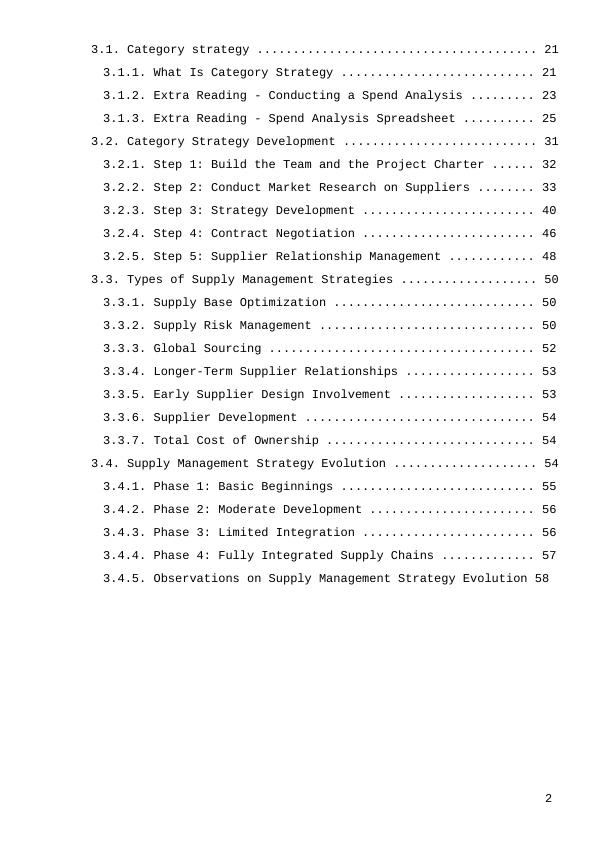
3
CHAPTER 2 – SUPPLY MANAGEMENT STRATEGY
1. Integration & The Role of Supply Management
Purchasing offices were once corporate backwaters, filled with
people who didn’t dream of advancing to the top rungs of their
organizations. Many buyers saw themselves as industrial bureaucrats,
filing purchase orders with the same short list of familiar, mostly
nearby suppliers. When possible, they avoided the complex process of
assessing potential new suppliers, especially those overseas.
Top supply managers today need different skills and often have
higher aspirations. Sometimes they’re engineers or others with
operating experience that gives them more intimate knowledge of how
their company’s products are made.
Today’s transformation in buying was made possible by a
technological breakthrough more than a decade ago, when companies
began installing computer systems that record their every transaction.
This often revealed startling weaknesses. For instance, many companies
found that different divisions—or even different offices down the hall
from one another—were sometimes paying different prices for the same
product bought from outside suppliers.
Purchasing managers play a role as highly effective cost cutters,
though that part of their job has some surprising nuance. To be sure,
buyers save companies huge amounts by trolling the world for new,
lower-cost sources, and this is certainly a big reason for their
growing stature at many multinationals. But in an era of scarce
commodities and the risks of disruptions to supply lines posed by
terrorist attacks or striking dockworkers, they also have to make sure
they pick dependable sources—which might mean choosing the more
expensive source just to ensure no disruptions.
Different functions or groups within any organization must work
together to achieve a wide range of common goals—from the reduction
of product cost and improved product quality and delivery to the
development of innovative new products. Supply management plays an
active role in supporting such performance objectives, interacting
with and supporting the needs of groups within the organization and
outside of it. How does supply management achieve this? Supply
integration involves professionally managing suppliers and developing
close working relationships with different internal groups. The
central theme of this chapter is that supply management must become
closely integrated with other internal and external functions in order
to develop the capabilities that will lead to improved competitive
CHAPTER 2 – SUPPLY MANAGEMENT STRATEGY
1. Integration & The Role of Supply Management
Purchasing offices were once corporate backwaters, filled with
people who didn’t dream of advancing to the top rungs of their
organizations. Many buyers saw themselves as industrial bureaucrats,
filing purchase orders with the same short list of familiar, mostly
nearby suppliers. When possible, they avoided the complex process of
assessing potential new suppliers, especially those overseas.
Top supply managers today need different skills and often have
higher aspirations. Sometimes they’re engineers or others with
operating experience that gives them more intimate knowledge of how
their company’s products are made.
Today’s transformation in buying was made possible by a
technological breakthrough more than a decade ago, when companies
began installing computer systems that record their every transaction.
This often revealed startling weaknesses. For instance, many companies
found that different divisions—or even different offices down the hall
from one another—were sometimes paying different prices for the same
product bought from outside suppliers.
Purchasing managers play a role as highly effective cost cutters,
though that part of their job has some surprising nuance. To be sure,
buyers save companies huge amounts by trolling the world for new,
lower-cost sources, and this is certainly a big reason for their
growing stature at many multinationals. But in an era of scarce
commodities and the risks of disruptions to supply lines posed by
terrorist attacks or striking dockworkers, they also have to make sure
they pick dependable sources—which might mean choosing the more
expensive source just to ensure no disruptions.
Different functions or groups within any organization must work
together to achieve a wide range of common goals—from the reduction
of product cost and improved product quality and delivery to the
development of innovative new products. Supply management plays an
active role in supporting such performance objectives, interacting
with and supporting the needs of groups within the organization and
outside of it. How does supply management achieve this? Supply
integration involves professionally managing suppliers and developing
close working relationships with different internal groups. The
central theme of this chapter is that supply management must become
closely integrated with other internal and external functions in order
to develop the capabilities that will lead to improved competitive
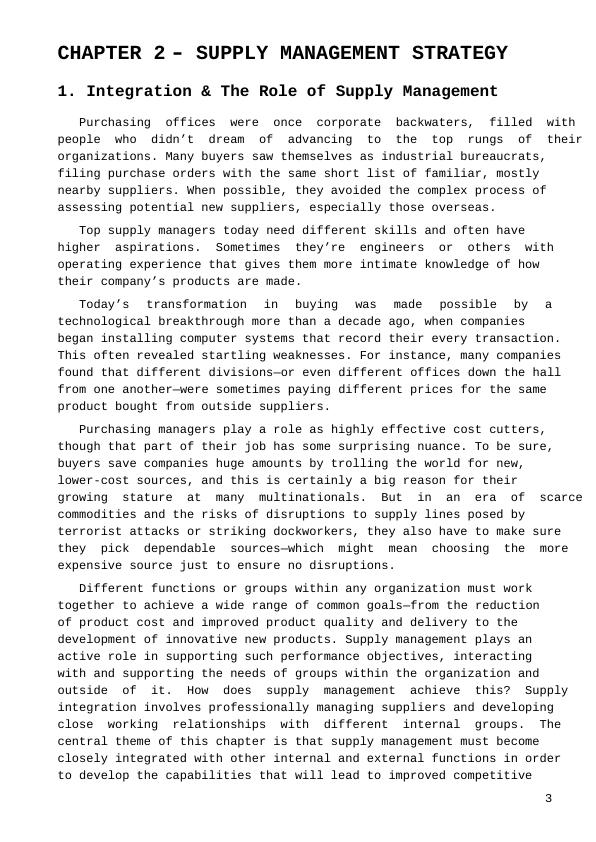
4
performance. Integration spans a number of areas, including finance,
engineering, logistics, service operations, production, new-product
development, and customer service.
1.1. Definition
Integration, a term often heard in the popular press, is in many
cases not well defined. In this text, we define integration as “the
process of incorporating or bringing together different groups,
functions, or organizations, either formally or informally, physically
or by information technology, to work jointly and often concurrently
on a common business-related assignment or purpose.” Although this is
a very broad definition, it implies certain elements.
First, that people are coming together to work together on a
problem. It is no surprise that “two heads are better than one” when
it comes to solving problems, but many enterprises do not apply the
idea of bringing together people with a different point of view to
solve a common problem. This is especially true in a global
environment, with team members located all over the world. Thus,
another caveat to this definition involves doing so either formally
or informally, through physical methods or by information technology.
Finally, integration requires that people create a common
understanding of the end goal or purpose; as we will see, this is an
important aspect of the success of integration strategies.
A recent study of senior executives in the United States and Europe
indicated that integration is at the top of these executives’ minds,
in terms of what will be required in the future.1 Moreover, when asked
about the most critical skills required for supply management managers
in the year 2010, executives did not list some of the more common
elements such as process focus, financial analysis, or efficiency. The
single most important element that senior executives look for is
relationship management (RM) skills, defined as the ability to act
ethically, listen effectively, communicate, and use creative problem
solving. The ability to drive relationships is critical for firms
seeking to build strong integration with internal business functions,
as well as with external suppliers.
Integration can occur in many forms. It can occur through functions,
such as in sourcing or new-product development teams. It can also
occur through cross-location teams, where people from different
business units are brought together. Finally, the most difficult and
challenging form is cross-organizational teams, which involves working
with suppliers, customers, or even both concurrently! Bringing
different people to the table to work on a problem can provide
performance. Integration spans a number of areas, including finance,
engineering, logistics, service operations, production, new-product
development, and customer service.
1.1. Definition
Integration, a term often heard in the popular press, is in many
cases not well defined. In this text, we define integration as “the
process of incorporating or bringing together different groups,
functions, or organizations, either formally or informally, physically
or by information technology, to work jointly and often concurrently
on a common business-related assignment or purpose.” Although this is
a very broad definition, it implies certain elements.
First, that people are coming together to work together on a
problem. It is no surprise that “two heads are better than one” when
it comes to solving problems, but many enterprises do not apply the
idea of bringing together people with a different point of view to
solve a common problem. This is especially true in a global
environment, with team members located all over the world. Thus,
another caveat to this definition involves doing so either formally
or informally, through physical methods or by information technology.
Finally, integration requires that people create a common
understanding of the end goal or purpose; as we will see, this is an
important aspect of the success of integration strategies.
A recent study of senior executives in the United States and Europe
indicated that integration is at the top of these executives’ minds,
in terms of what will be required in the future.1 Moreover, when asked
about the most critical skills required for supply management managers
in the year 2010, executives did not list some of the more common
elements such as process focus, financial analysis, or efficiency. The
single most important element that senior executives look for is
relationship management (RM) skills, defined as the ability to act
ethically, listen effectively, communicate, and use creative problem
solving. The ability to drive relationships is critical for firms
seeking to build strong integration with internal business functions,
as well as with external suppliers.
Integration can occur in many forms. It can occur through functions,
such as in sourcing or new-product development teams. It can also
occur through cross-location teams, where people from different
business units are brought together. Finally, the most difficult and
challenging form is cross-organizational teams, which involves working
with suppliers, customers, or even both concurrently! Bringing
different people to the table to work on a problem can provide
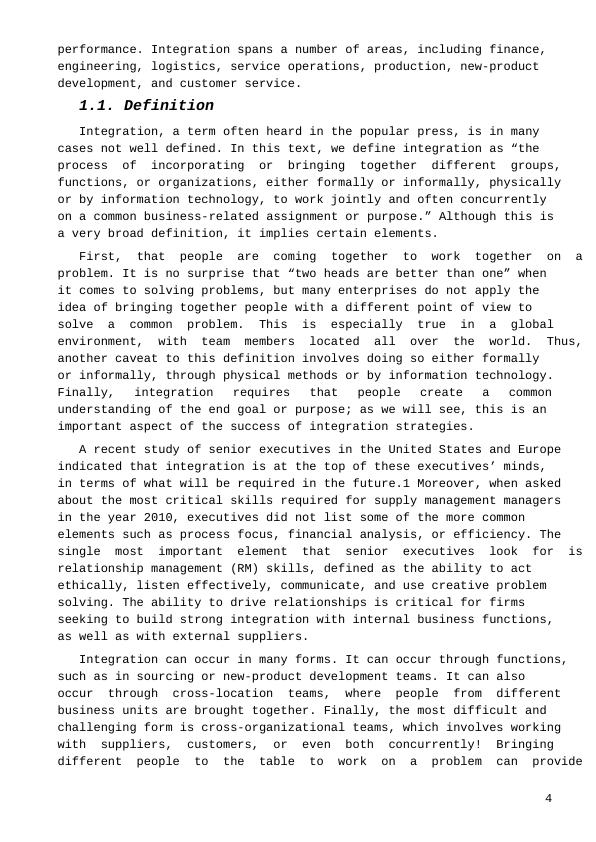
5
significant benefits. People will generally provide input in the form
of the following:
• Information
• About their markets
• About their own plans and requirements
• Knowledge and expertise
• Product and service knowledge and technology
• Process knowledge and understanding of how to make it work
• Business advantages
• Favorable cost structures that can benefit customers
• Economies of scale, which can also help reduce costs
• Different perspective on an issue, which may drive a team to look
at the problem from a new perspective that they hadn’t thought of
before.
Some of the different methods that supply management will apply to
achieve integration include the following:
• Cross-functional or cross-organizational committees and teams
• Information systems such as videoconferencing and webmail
• Integrated performance objectives and measures that drive a
common goal
• Process-focused organizations that are dedicated to certain
processes
• Co-location of suppliers and customers
• Buyer or supplier councils that provide input and guidance to a
steering Committee
Paradoxically, the very elements of sound supply chain business
practice that are the cornerstones of mature spend management
cultures—and a crucial foundation for supplier relationship management
(SRM)—can also serve as an anchor holding back progression to the
higher levels of success.
One part of breaking through is tied to the personal effectiveness
of the supply chain professionals charged with doing the work. Supply
management professionals must begin to work with their internal
functions, not against them! This means that the key building blocks
for integration (team-building, communication, and relationship
management) will become more important than ever! Let’s discuss the
significant benefits. People will generally provide input in the form
of the following:
• Information
• About their markets
• About their own plans and requirements
• Knowledge and expertise
• Product and service knowledge and technology
• Process knowledge and understanding of how to make it work
• Business advantages
• Favorable cost structures that can benefit customers
• Economies of scale, which can also help reduce costs
• Different perspective on an issue, which may drive a team to look
at the problem from a new perspective that they hadn’t thought of
before.
Some of the different methods that supply management will apply to
achieve integration include the following:
• Cross-functional or cross-organizational committees and teams
• Information systems such as videoconferencing and webmail
• Integrated performance objectives and measures that drive a
common goal
• Process-focused organizations that are dedicated to certain
processes
• Co-location of suppliers and customers
• Buyer or supplier councils that provide input and guidance to a
steering Committee
Paradoxically, the very elements of sound supply chain business
practice that are the cornerstones of mature spend management
cultures—and a crucial foundation for supplier relationship management
(SRM)—can also serve as an anchor holding back progression to the
higher levels of success.
One part of breaking through is tied to the personal effectiveness
of the supply chain professionals charged with doing the work. Supply
management professionals must begin to work with their internal
functions, not against them! This means that the key building blocks
for integration (team-building, communication, and relationship
management) will become more important than ever! Let’s discuss the

6
first of these integration elements: internal integration with the
functional entities in their own enterprise!
1.2. Internal Integration - Supply Management’s
Internal Linkages
Supply management must maintain a number of communication flows and
linkages. Exhibit 4.1 illustrates the two-way linkages between supply
management and other key groups along with a sample of the information
exchanged between these groups. The linkages between supply management
and other groups will become even stronger and more important as the
role of supply management continues to develop and evolve.
To facilitate integration with other internal functions, a number
of critical communication linkages or interfaces have evolved between
supply management and other departments. This need for internal
integration has increased exponentially in the last five years. Many
first of these integration elements: internal integration with the
functional entities in their own enterprise!
1.2. Internal Integration - Supply Management’s
Internal Linkages
Supply management must maintain a number of communication flows and
linkages. Exhibit 4.1 illustrates the two-way linkages between supply
management and other key groups along with a sample of the information
exchanged between these groups. The linkages between supply management
and other groups will become even stronger and more important as the
role of supply management continues to develop and evolve.
To facilitate integration with other internal functions, a number
of critical communication linkages or interfaces have evolved between
supply management and other departments. This need for internal
integration has increased exponentially in the last five years. Many

7
organizations have actively moved toward an outsourced environment,
and in some cases are sourcing all products through low-cost-country
sourcing environments or contract manufacturers. These environments
are very different from North American buyer-seller situations, and
supply management must play a critical role in establishing these
agreements and identifying global requirements for success. Supply
management must often work to become part of the global negotiations
teams and become involved in supplier qualification, contract
management, and logistics, working with multiple internal parties in
the firm including finance, legal, logistics, marketing, and
operations.
1.2.1. Operations
Supply management has always been a major supporter of the
operations group. Because the links between operations and supply
management have been so close, it has not been unusual for supply
management to report directly to operations. A major link between
operations and supply management is through the development of global
operations strategy. Because supply management directly supports
operations, it must develop insights into production or service
strategic plans. One area in which supply management has critical
input to operations (and marketing) is through the sales and operations
plan, which identifies the level of production and sales for six months
to one year, as well as the required input to execute the plan.
Clearly, supply management’s strategies and plans must be aligned
with the sales and operations plan. For example, supply management
must be aware of the components and services needed by operations as
they plan to fulfill customer requirements for products or services.
This could include materials, software, services, travel, hotel,
information technology, and outsourced labor. Because supply
management is responsible for sourcing the inputs to support
operation’s plans, supply management managers must work with
operations to coordinate the execution to plan.
Supply management and operations also maintain communication
linkages through direct personnel contact. Many firms are now co-
locating supply management personnel directly at operating locations
so supply management can respond quickly to operation’s needs. For
example, in many financial institutions, supply managers are co-
located within the strategic business units and provide supplier
relationship managers to act as a primary single point of contact
between suppliers and the organization. These managers can work to
identify problems, create problem resolution strategies, and act as a
liaison for discussions of service management expectations.
organizations have actively moved toward an outsourced environment,
and in some cases are sourcing all products through low-cost-country
sourcing environments or contract manufacturers. These environments
are very different from North American buyer-seller situations, and
supply management must play a critical role in establishing these
agreements and identifying global requirements for success. Supply
management must often work to become part of the global negotiations
teams and become involved in supplier qualification, contract
management, and logistics, working with multiple internal parties in
the firm including finance, legal, logistics, marketing, and
operations.
1.2.1. Operations
Supply management has always been a major supporter of the
operations group. Because the links between operations and supply
management have been so close, it has not been unusual for supply
management to report directly to operations. A major link between
operations and supply management is through the development of global
operations strategy. Because supply management directly supports
operations, it must develop insights into production or service
strategic plans. One area in which supply management has critical
input to operations (and marketing) is through the sales and operations
plan, which identifies the level of production and sales for six months
to one year, as well as the required input to execute the plan.
Clearly, supply management’s strategies and plans must be aligned
with the sales and operations plan. For example, supply management
must be aware of the components and services needed by operations as
they plan to fulfill customer requirements for products or services.
This could include materials, software, services, travel, hotel,
information technology, and outsourced labor. Because supply
management is responsible for sourcing the inputs to support
operation’s plans, supply management managers must work with
operations to coordinate the execution to plan.
Supply management and operations also maintain communication
linkages through direct personnel contact. Many firms are now co-
locating supply management personnel directly at operating locations
so supply management can respond quickly to operation’s needs. For
example, in many financial institutions, supply managers are co-
located within the strategic business units and provide supplier
relationship managers to act as a primary single point of contact
between suppliers and the organization. These managers can work to
identify problems, create problem resolution strategies, and act as a
liaison for discussions of service management expectations.
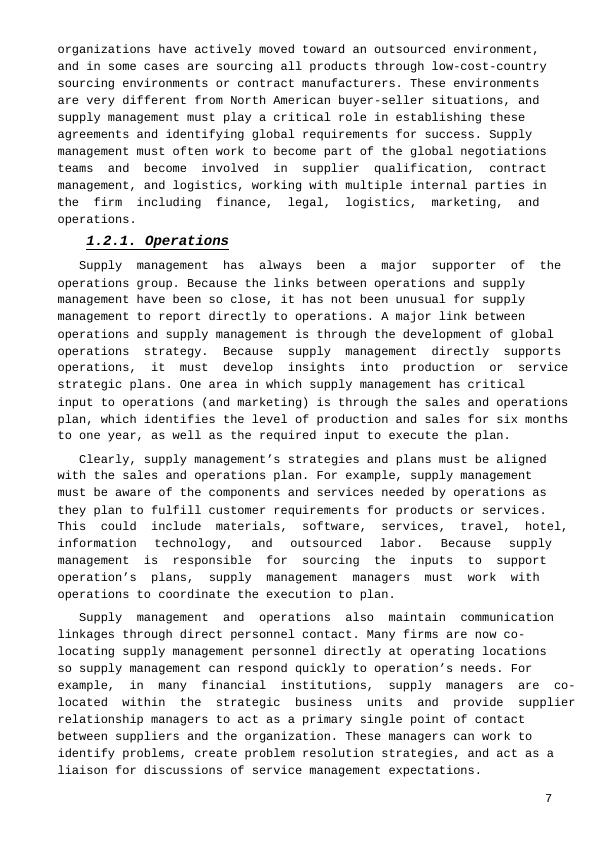
8
1.2.2. Quality Assurance
The supply management–quality linkage has increased in importance
during the last 10 years. As firms externally source a larger
percentage of finished product requirements, supply management and
quality assurance must work together closely to ensure that suppliers
perform as expected. Joint projects involving these two groups include
supplier quality training, process capability studies, and corrective
action planning. This linkage has become so important that some firms
have placed the responsibility for supplier quality management
directly with supply management. Many firms now have a dedicated
supplier quality management function with a dual reporting element to
both quality and supply management.
1.2.3. Engineering
Perhaps the most important and challenging linkages exist between
supply management and engineering. The need to develop quality
products in less time has drawn supply management and engineering
closer over time. There are still opportunities, however, to improve
the level of interaction between these two groups.
Firms can create stronger communication linkages and flows between
supply management and engineering in several ways. Engineers and
buyers can develop open communication by working together on product
development or supplier selection teams. Supply management can also
co-locate a buyer within the engineering group. The buyer can maintain
direct contact with product and process engineers to respond quickly
to their needs. A firm can also appoint a liaison that coordinates
interdepartmental communications and makes sure that each group is
aware of the other group’s activities. The two departments can hold
regular meetings to report on items of mutual concern. Finally, many
supply management groups are recruiting commodity managers with very
strong technical backgrounds, who are able to talk the talk and walk
the walk alongside their engineering counterparts. The key to a
successful relationship between supply management and engineering is
open and direct communication, which in turn should lead to increased
teamwork and trust.
Engineering looks to supply management to perform certain tasks to
support engineering’s efforts. For example, engineering expects supply
management to identify the most technically and financially capable
supplier for an item and to make sure each supplier meets engineering’s
quality and delivery targets. In addition, engineering expects supply
management to assess a supplier’s production capabilities, actively
involve suppliers early in the design process, and develop
relationships that encourage a supplier to offer innovative ideas.
1.2.2. Quality Assurance
The supply management–quality linkage has increased in importance
during the last 10 years. As firms externally source a larger
percentage of finished product requirements, supply management and
quality assurance must work together closely to ensure that suppliers
perform as expected. Joint projects involving these two groups include
supplier quality training, process capability studies, and corrective
action planning. This linkage has become so important that some firms
have placed the responsibility for supplier quality management
directly with supply management. Many firms now have a dedicated
supplier quality management function with a dual reporting element to
both quality and supply management.
1.2.3. Engineering
Perhaps the most important and challenging linkages exist between
supply management and engineering. The need to develop quality
products in less time has drawn supply management and engineering
closer over time. There are still opportunities, however, to improve
the level of interaction between these two groups.
Firms can create stronger communication linkages and flows between
supply management and engineering in several ways. Engineers and
buyers can develop open communication by working together on product
development or supplier selection teams. Supply management can also
co-locate a buyer within the engineering group. The buyer can maintain
direct contact with product and process engineers to respond quickly
to their needs. A firm can also appoint a liaison that coordinates
interdepartmental communications and makes sure that each group is
aware of the other group’s activities. The two departments can hold
regular meetings to report on items of mutual concern. Finally, many
supply management groups are recruiting commodity managers with very
strong technical backgrounds, who are able to talk the talk and walk
the walk alongside their engineering counterparts. The key to a
successful relationship between supply management and engineering is
open and direct communication, which in turn should lead to increased
teamwork and trust.
Engineering looks to supply management to perform certain tasks to
support engineering’s efforts. For example, engineering expects supply
management to identify the most technically and financially capable
supplier for an item and to make sure each supplier meets engineering’s
quality and delivery targets. In addition, engineering expects supply
management to assess a supplier’s production capabilities, actively
involve suppliers early in the design process, and develop
relationships that encourage a supplier to offer innovative ideas.
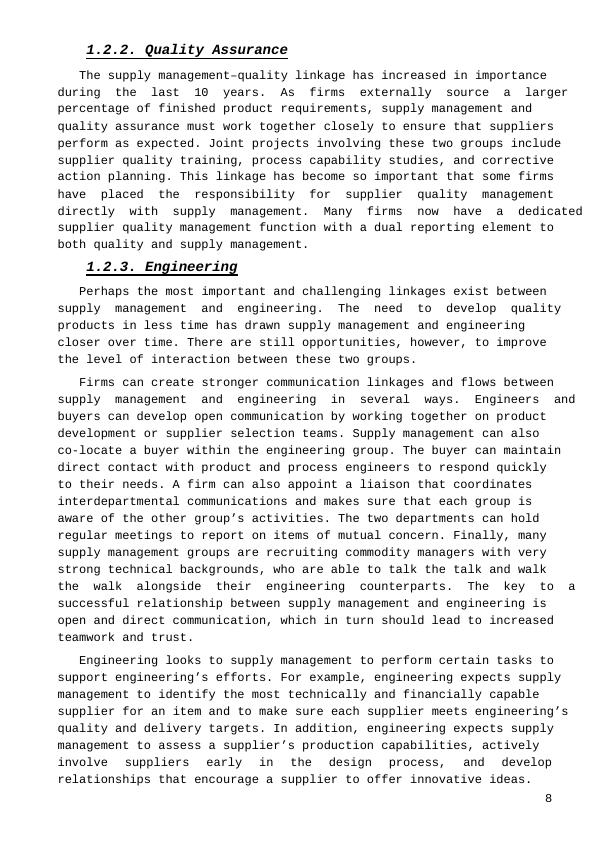
End of preview
Want to access all the pages? Upload your documents or become a member.
Related Documents
UNDERSTANDING PROJECT PROCUREMENTlg...
|7
|756
|16